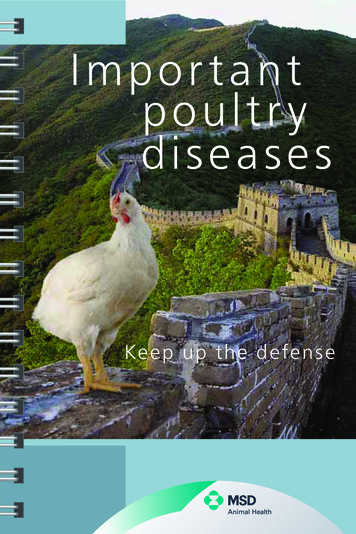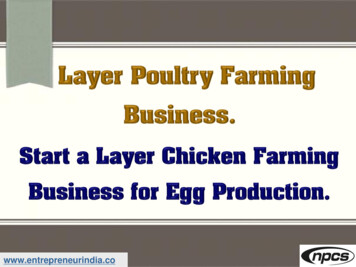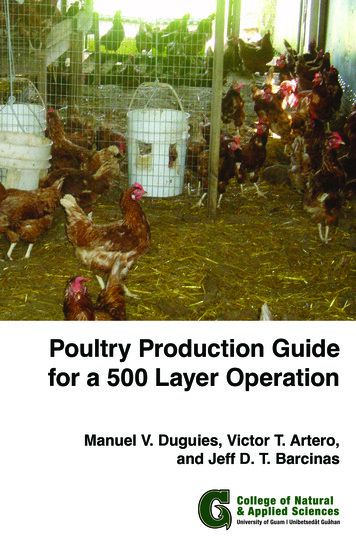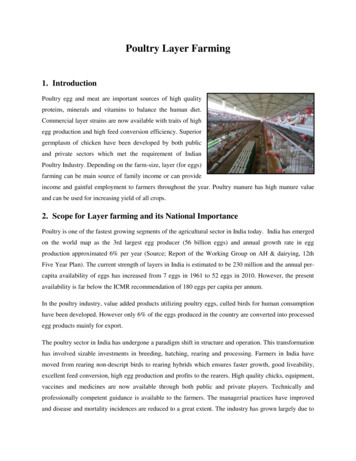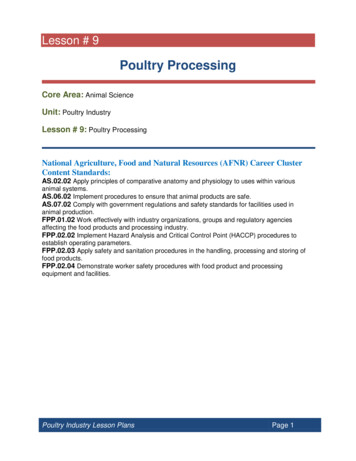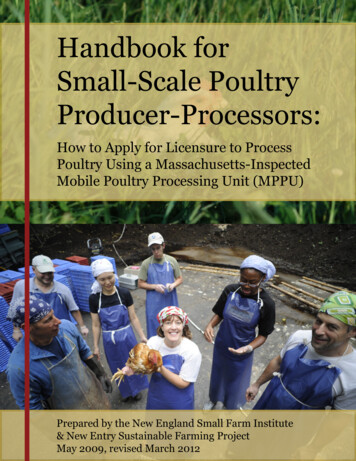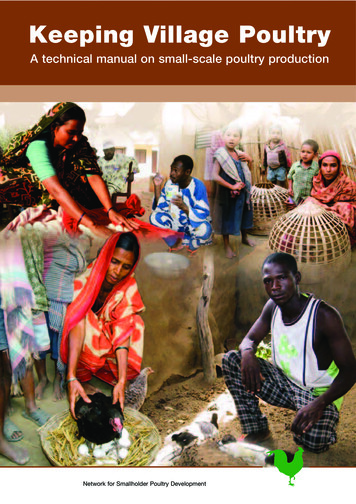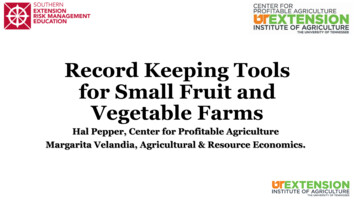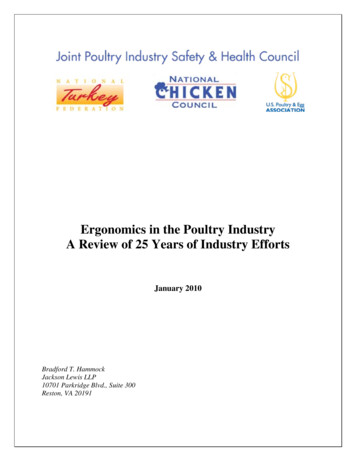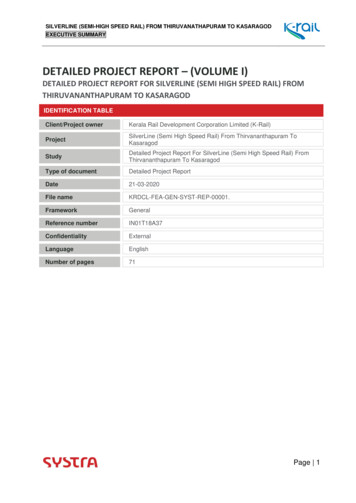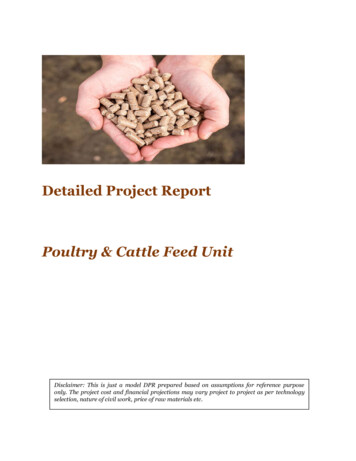
Transcription
Detailed Project ReportPoultry & Cattle Feed UnitDisclaimer: This is just a model DPR prepared based on assumptions for reference purposeonly. The project cost and financial projections may vary project to project as per technologyselection, nature of civil work, price of raw materials etc.
Table of Content:1Introduction . 41.1Poultry Sector in India: . 61.2Export Trend . 81.2.12Main Market Player:. 8Project Description . 9Considering the opportunities in terms of gap between demand of animal feed and existingmanufacturing capacity, and the easily available raw material at Bihar, the project aims atsetting up a unit for manufacturing poultry and cattle feed. . 92.134Main Products . 9Manufacturing Process . 103.1Technology . 113.2Process Description . 113.3Material Handling . 123.4Grinding . 123.5Mixing . 123.6Conditioning . 123.7Pelleting . 133.8Cooling . 133.9Process flow . 13Raw Material Requirement. 144.1Raw Material Sourcing Plan . 155Marketing Plan . 176Project Cost, Means of Finance and Financial Analysis . 176.1Project Cost . 186.1.1Civil and Land Development Costs . 186.1.2Equipment’s . 196.1.3Miscellaneous Fixed Assets/ Utilities . 196.1.4Preliminary & Pre-Operative Expenses: . 20
6.1.5Working Capital Requirement: . 206.1.6Contingencies: . 206.2Means of Finance . 216.2.1Raw Material Requirement and Cost . 216.2.2Packing Material . 226.2.3Power requirement: . 236.2.4Employee Cost . 236.2.5Cost of Insurance and Maintenance . 236.2.6Admin Overhead Cost . 236.2.7Selling Expenses . 236.3Financial Assumption . 236.3.1Interest. 246.3.2Depreciation Rates . 246.3.3Revenue Assumption . 246.3.4Capacity Utilization. 256.4Projected Financial Performance: . 256.4.1Project Profitability Statement: . 256.4.2Project Financial Indicator . 276.4.3Project Cash Flow Statement . 276.4.4Projected Balance Sheet . 28
1 IntroductionLivestock plays an important role in Indian economy. About 20.5 million people depend upon livestockfor their livelihood. Livestock contributed 16% to the income of small farm households as against anaverage of 14% of all households. It also provides livelihood to two-third of rural community. Itcontributes approximately 5.1% to the country’s GDP and 17.1 1% to the Agricultural GDP. It also providesnutritional security to the poor in addition to offering employment opportunity to millions of ruralIndians. The Indian animal feed industry is broadly categorized into Poultry, Cattle and Aqua feed(majorly Fish). Though the organized sector is quite old, it is still in a nascent stage, supplying only 10 percent of cattle and aqua feed and 50 per cent of poultry feed in India, says a Rabobank report. The bulk ofthe remaining feed is being produced by the unorganized sector, which comprises of household industriesand custom mixers. The total production 2 of compound feed for all livestock stands at 17 million tones.Figure 1: Livestock Population 2020-Share of Major Species1NationalAccount Statistics-2019, Central Statistical Organization, GoI2http://www.wattagnet.com
Livestock Population 2019-Share of Major 20%Source: Livestock Census, 2020The demand for poultry, Meat and Egg products in India is highly income-and price-elastic while supplyfor these products is also highly price elastic. India, the world’s second largest developing economy, nowhas a large and rapidly expanding poultry and livestock sector. Development in India is being driven byrising incomes of the consuming masses and a shift in industry structure toward integrated ownershipand coordination of the input, production, and marketing operations involved in production.Figure No. 2- Below graph shows a comparison between Consumption pattern mix of an average Indianconsumer in 2007 as compared to that of 0%2000Cereals & Bread2007PulsesFruits & VegetablesMilk & Milk ProductsMeat, Egg & FishThe shift from cereal diet towards Milk, Meat, Egg and Fish products is very clearly visible from the dataand it connotes of an emerging market opportunity in Livestock, Dairy and poultry products in the nearfuture. This not only calls for improved market linkages for feeding the increasing mouths but also asks
for improved backward linkages in terms of better rearing methods, up - gradation of the geneticpotential of the existing animal breed , improved availability of better fodder and feed, better storagefacility for the perishable products and better farm to market linkages.There has been a considerable shift in the Consumption pattern and the scenario has been drifting in thefavor of Poultry and Dairy products.Figure 3: Below Graph depicts the projected growth rate for different food Diary4.0%PoultryFruitsVegetablesProjected Growth Rate of Consumption in 2020The graph clearly depicts the positive growth rate in consumption of Poultry, Dairy products and in Fruitsand Vegetables.To get clearer picture of the emerging scenario, an illustrated view of Poultry sector is detailed below.1.1 Poultry Sector in India:India is the third-largest egg producer in the world after China and the USA and the fourth-largestchicken producer in the world after China, Brazil and the USA. In India, the per capita consumption ofeggs has gone up from 30 eggs per annum to 68 eggs per annum, and that of chicken from 400 gms perannum, to 2.5 kg per annum in the last 5 years. Human nutritionists recommend a minimum of 180 eggs& 10 kg chicken per annum for a healthy adult human, which means that the Indian poultry market isladen with opportunities. Adult population in most developed countries consume over 240 eggs and 20 kgof chicken per annum.India has 1.23 billion people and the number is growing every year. The focus is on “Development”,meaning good food, better health & living conditions for everyone. People spend more money on foodwhen they earn more. Healthy food at attractive price will therefore be the issue in focus. Eggs andchicken are accepted by almost all communities and is available across the country at reasonable prices.Poultry is the most organised sector in animal agriculture in India, worth Euro 14,500 million. Productionof broiler meat has increased to 4.2 million tons per annum in 2015-16. Demand for processed chickenmeat has been growing by 15- 20% per annum. Total layer production in India has gone up to reach 80million eggs per annum. Industry sources estimate CY 2016-17 feed consumption to go from 17 to 18million tons, which includes corn and soya bean and pearl millet.Eggs and chicken were “agriculture produce” few years ago but are considered as “food items” today. Safefood has become a priority. Besides maintaining his production efficiency, the producer has to
concentrate on the nutritive values, the adulterants and contaminants of his produce. The ministry of foodprocessing industries at the central govt. level and food inspection authorities at the local levels havestarted keeping track of eggs and chicken production in India for quality and nutrients.Poultry Production has three segments: 1. Layers, 2. Broilers, 3. Backyard / Family Production (Both eggsand chicken).Distribution of Poultry PopulationDuckOthersBroilerBackyard PoultryDuckOthersBackyard PoultryLayerLayerBroilerSource: dahd.nic.inTable 1. Requirement of Eggs Production Target 2022-23ParameterEggsCommercial LayersBaseline Data (2015-16)83 Billion375 BillionYield- eggs/ annum (takingacross India for all varieties)Total Feed Required220Feed Ingredient- Maize @ 35%4 MMTRequired by 2022136 Billion550 Billion (additional 175million layers required over baseperiod)250 (Taking nearly 15% increasein yield)15 MMT (also factoring 7%improvement in FCR with 42 kgper bird in a laying cycle)5.25 MMTFeed Ingredient- Soya @ 15%1.7 MMT2.25 MMT11 MMT (annualized @ 45 Kg in alaying cycle)Source: dahd.ac.inBroilersFeed (65%) and chicks (25%) account for 90% of the broiler inputs and consolidation is being observed inthe market. Smaller producers engage in ‘contract farming.Backyard / family production
At one time, 30% of the eggs produced in India were produced in the backyards. Improved varieties of‘Low technology input birds’, which are dual purpose, i.e., producing eggs and meat, are new being bred inIndia for the purpose of backyard/family production. The final food products, i.e., eggs and chicken arenot exported in huge quantities as there is a huge gap in supply and demand within India.Table 2: Requirement for Poultry Production Target 2022-23ParameterPoultry (Chicken meat)Commercial BroilersBaseline Data (2015-16)3.26 MT3326 millionCarcass cutting yield in Kg(taking across India for allvarieties)Total Feed Required0.98 (70% of carcass yield)Feed Ingredient- Maize @ 40%Feed Ingredient- Soya @ 20%Vaccine dosages required (4/bird)Skilled persons requirement(total for poultry sector)Entrepreneurship Development&EmploymentGeneration(Total for poultry sector)Poultry Processing Capacity(Bird per hour in organized,small and unorganized sector)Exports- major poultry productsInvestmentrequiredonoperating cost for additionalbroilers4.8 MMT2.4 MMT13300 dosagesRequired by 20226.20 MT5167 million (additional 1840million broilers required overbase period- additional 31-32million chick placement eachweek)1.2 (Taking nearly 15% increasein carcass yield & 75% carcasscutting yield)15.50 MMT (also factoring 7%improvement in FCR i.e. 1.6 with3 kg per bird)6.2 MMT3.1 MMT20668 dosages1.85 lakh5.5 lakh1,6308,00086,500 B.P.H1,40,000 B.P.H. (@ 10% CAGR)Rs. 30 CroreRs. 1360 CroreOperational Cost – Rs. 18,400Crore (@ Rs. 100/ bird)12 MMT (@ 3.5 Kg per bird: 1.7FCR)Source: dahd.nic.in1.2 Export TrendAs per Agriculture and Processed Foods Products Export Development Authority (APEDA), India hasexported 659,304 MT of poultry products for the worth of INR 7,680 million during 2015-16. Majority ofthe exports are destined for the Middle East. Each year, India exports around 5000 MT of poultryproducts into Europe, the largest chunk of which is destined for Germany, although the share of theNetherlands has grown significantly over the last few years.1.2.1Main Market Player:As per Agriculture and Processed Foods Products Export Development Authority (APEDA), India hasexported 659,304 MT of poultry products for the worth of INR 7,680 million during 2015-16. Majority of
the exports are destined for the Middle East. Each year, India exports around 5000 MT of poultryproducts into Europe, the largest chunk of which is destined for Germany, although the share of theNetherlands has grown significantly over the last few years.The key stakeholders in the Indian poultry market are as follows.a) Sneha Foods Limited, Telanganab) Srinivasa Hatcheries (SH Group), Telanganac) Balaji Hatcheries, Andhra Pradeshd) V S N Hatcheries, Andhra Pradeshe) Mulpuri Group, Andhra Pradeshf) Venky’s (V H Group), Maharashtra g) Suguna Foods, Tamil Naduh) R M Group, Haryana. I) Skylark Foods, Haryanaj) Komarla Group, Karnatakak) I B Group, Chattisgarhl) Bharati Poultry, West Bengal2 Project DescriptionConsidering the opportunities in terms of gap between demand of animal feed and existing manufacturingcapacity, and the easily available raw material at Bihar, the project aims at setting up a unit formanufacturing poultry and cattle feed.The proposed project is for establishment of animal feed (approx. 80% poultry feed and 20% cattle feed)unit of 12,000 MT per year capacity.The project also aims at creating storage infrastructure to meet the storage requirement of raw materialand final produce.As far as marketing of finished goods i.e. poultry feed and cattle feed are concerned, the companyenvisages selling the same within the state and also to the other states like UP, West Bengal andJharkhand etc.The current chapter and the subsequent chapters of the report describe the various aspects of the projectas envisaged by the promoters for starting the project and as it is expected to be operational in the comingyears.2.1 Main Products
The major products that are proposed to be manufactured in the unit are:1.Poultry Feed: This would be the main product of the unit. The production will be done underthe following subcategories: Pre-Starter Feed – It is used for chicks of 0 to 10 days of age. It is a balanced nutritive Chickfeed with uniform crumbs. Starter Crumbs Feed – Useful for chicks 11 to 28 days chicks. Finisher Crumbs / Pellet Feed – Used In 29-42 says old chicks.2. Cattle feed: This would be the second product of the company.3 Manufacturing ProcessThe proposed unit will majorly be producing pellet feed for poultry birds which is supposed to be a wellbalanced diet for poultry birds. Pellet feed is considered as most concentrated form of feed, havingoptimum combination of moisture, heat and pressure and most digestible feed. A good quality feed hasfour components which are as follows: Ingredient quality Process Control Updated technology Control of toxic substancesTechnology for the unit has been chosen carefully keeping in mind the best practices observed in Industryand local processes that may add unique value to the final produce. Details of the technology and processare described hereafter.
3.1 TechnologyThe unit will use modern technology like use of Hammer mill, Batch mixer, Pellet mill and pellet cooler.The picture below depicts the process involved in the manufacturing of Poultry feeds:The technology to be used in the plant is well proven and is proposed to be procured from reputedsupplier. Certain advantages of the proposed technology over that of the traditional methods are asfollows:Use of Hammer Mill: Full circle hammer mill brings economic and efficient grinding. Otheradvantages include 360-degree screen which gives maximum area for grinding, reversible rotation forreducing down time and large bottom discharge.Batch mixer: Horizontal type batch mixer is designed for homogenous mixing. Its slow speed mixinghandles the material gently with low heat generation.Pellet Cooler: The counter flow pellet cooler has automatic control for optimum cooling. Its air flowopposite to movement of hot pellets results in fast cooling and removal of moisture.Use of such improved technology will enhance the quality of final produce and may add unique value tothe final produce.3.2 Process Description
The process of manufacturing Animal Feeds is almost the same for Poultry, Cattle and Aqua except theRaw materials used for different feeds have different compositions. The process of manufacturingconcentrated poultry and cattle feed is continuous and automatic. The slight variation comes after mixingof raw material for the feed type.A brief overview of various stages/sections involved in manufacturing ofpoultry feed is given below:3.3 Material HandlingRaw materials stored in storage area are sent for weighing. High degree of accuracy and precision isrequired for weighing. After that ingredients are sent to laboratory for analysis. After acceptance fromfeed laboratory, these ingredients are sent for grinding with the help of equipment’s like conveyor andelevators.3.4 GrindingThe grinding of the grain facilitates digestion, and as a result, the diet’s nutritional efficiency improves aswell. The materials picked up by elevator are dropped in the hammer mill for grinding.Full circle hammer mills are to be used for grinding. A special care must be taken to keep moisture lossesless than 2% on any material during grinding.3.5 MixingMixing the diet homogeneously is very important so that the animals can receive all the necessarynutrients in every portion of the food they ingest.Double ribbon blender is used to mix all ingredients after grinding. Following to be taken care of duringthe process: ACV3 of less than 10 should be achieved on all formulations and in all grinding sizes. Degree of homogeneity in liquids mixing should be in excess of 85%. Mixing parameters should be achieved in less than grinding time.3.6 ConditioningDirect and indirect injection of steam in material for a range of 10-50 seconds is done. Conditioner shouldhave provision for varying conditioning time as per formulation requirement. It should also be havingcleaning windows for maintenance and cleaning of internal walls and components.3ACV: Apple Cider Vinegar
3.7 PelletingSuitable pellet mills capable of producing feed from 1.8 mm diameter to 10 mm diameter is needed. Thepositive effects of pelleting are higher feed density, no feed ingredient separation, better bacteriologicalquality, easier ingestion, improved growth and feed conversion ratio. Pelleting of meal leads to hardnessand increased durability of the feed meal.3.8 CoolingDue to steam conditioning and power consumption during extrusion from pellet mill, feed gets heated.Moisture levels also go up to 20% in feed due to steam addition. Thus, cooler should be capable of coolingand drying material to atmospheric temperature and 8% moistures.3.9 Process flowThe entire process from Raw material Sourcing to quality control mechanism is a meticulous and gradualprocess which needs very stern check and balance at each step. To maintain a uniform and high-qualityfinished product quality the promoters have to keep a vigil on each of the processes described earlier. Thediagram below lists the important activities in the process:
4 Raw Material RequirementCorn and soybean meal are the major feeds used in the broiler industry, but feed composition variessomewhat by region and season. A ration of corn and soybean meal is recognized as technically superiorfor raising broilers, but other ingredients are sometimes substituted based on availability and price.Animal feed for modern high-performance breed is blend of grains, protein meals, Vitamins, minerals anda number of feed additives pelleted and crumbled to suit ingestion by different age of animals. In case ofpoultry feeds, the consumption of raw materials per MT finished goods is given as under:
Raw MaterialsMaizeSoya ExtractionCalcium PowderMeat Bone MealMustard De Oiled Cake (DOC)OilSaltMethioninLysineDi Calcium Phosphate (DCP)Wheat and rice branOther Feed Supplements including molassesTOTAL1.00RM in 0.030.01In case of cattle feeds, the consumption of raw materials per MT finished goods is given asunder:Raw materialsMaizeOil SeedsRice BranDe Oiled Rice Bran (DORB)Mustard De Oiled Cake (DOC)Vit. / Min./MedicinesTOTALQuantity required in MT0.100.070.1600.4500.1500.071.004.1 Raw Material Sourcing PlanAs mentioned earlier, major ingredient for Animal feed is maize which accounts for more than 60% offeed formulation. India is the fifth largest producer of maize in the world contributing 3% of the globalproduction. Diversified uses of maize have prompted higher production in the country. Out of totalarrivals to the mandis nearly 75% of the maize produce is bought by the animal feed manufacturers and20% is purchased by the starch extractors.Bihar is a significant producer of maize in the country. In 2018-19, Bihar produced approximately3193.91(Thousand Metric Ton) of maize over an area of 669.48 (Thousands hectare of land) withproductivity of 4771 Kg/Hectare4.In Bihar, maize is grown throughout the year. Winter (Rabi) maize is cultivated mainly in Bihar with aproduction of 0.74 million MT, gives unique position to the State in national maize market.4Departmentof Agriculture, Government of Bihar
The current market size of hybrid corn seed in Bihar is estimated at 1, 60,000 Q ( INR 400 Cr. in valueterms) and is assumed to reach 1, 75,000 Q at the end of 2021-22 with CAGR of 2%, while discountingcrop shifting and market price factors. Backed by suitability of high yielding Rabi Corn, Bihar haswitnessed corn revolution in last decade. In this, almost 50% of the market size is limited to few privateplayers (MNCs) due to their diverse varietal portfolio, suited to different agro-ecological profiles of state.While technology — planting of highyielding single-cross hybrids — has played a major role in raisingBihar’s maize production, the breakthrough, has also came with surge in export demand. The exportboom benefited Bihar’s farmers in terms of price realisations, which soared from Rs 400 to Rs 1,200 perquintal between 2005 and 2012. The stretch from Purnia, Katihar and Bhagalpur to Madhepura, Saharsa,Khagaria and Samastipur – north of the Ganga and on either side of the Kosi – emerged as a corn beltwhere many farmers, big and small, harvested 50 quintals or more per acre. That was comparable to the180-200-bushel yields in the US Midwest heartland of Illinois, Iowa and Indiana (one bushel equals 25.4kg).Share of different districts in maize production in Bihar is shown in the figure below5:National Stock Exchange has opened its Information Centre at Maheshkhoont in Khagaria, the districtknown for maize production for organizing buyers-sellers interaction.At 100% capacity utilization of installed capacity of 12000 MT, the project will require 12240 MT of rawmaterial (feed mix6). The maize required will be purchased from different districts of Bihar keeping inmind the logistical viability.Other major ingredient is soya extraction which is the largest source of protein is proposed to be procuredfrom Madhya Pradesh as there are many soya extractions eed mix break up is given in chapter-8; section 8.3.1
5 Marketing PlanThe company proposes to sell its products in Bihar, Uttar Pradesh, West Bengal, Assam, Orissa, NorthEastern States and Jharkhand. A wide network of dealers shall be created by the sales and marketing teamof the company. The company proposes to sell its products under its own brand name.The proposed trade channel for marketing the product is as follows:ManufacturerDealersRetailersEnd usersThe demand for animal feed is mainly influenced by the awareness of farmers on the importance of thecompound feeds, size of population, and development of modern poultry farms and availability of theproduct at right price. Considering the extension programmers to be undertaken by the Department ofAnimal Husbandry and Task Force for development of Maize and Poultry in Bihar, the consumption ofAnimal feeds is expected to increase manifold.6 List of Statutory Clearances RequiredA suggestive list of clearances that unit would require to take:S. No.1234Approval and clearancesrequiredState Investment PromotionBoard, Stage – I clearanceConsent to EstablishGST registrationChange in land useDepartment/ Offices to beconsentedDepartment of IndustriesBihar State Pollution ControlBoardCommercial TaxesLand Revenue DeptStatus
56Electricity ConnectionRegistration under Factories ActNorth/South Bihar PowerDistribution Company Ltd.Office of Inspector of Factories7 Project Cost, Means of Finance and Financial AnalysisThe different financial aspects of the project are dealt in detail in this chapter. It explains the cost of theproject, the source of funds employed and the financial analysis of the project to understand its long-termviability and sustainability.7.1 Project CostThe Project is estimated to cost Rs. 184.12 Lacs and the detailed breakup of the cost of the Project isgiven below:PARTICULARSAMOUNT (Rs. In Lakh)Land DevelopmentBuildingsEquipmentUtilities & other fixed assetsPreliminary and Pre-Operative ExpensesContingenciesMargin Money for Working .1 Civil and Land Development CostsThe total estimated land requirement for the project would be 10000SqFT. The civil construction costshas been presented in the table below (Factory building either be RCC or PEB structure so the layoutplan and cost may vary project to project same will be captured in an applicant’s DPR):SlNoComponentUnit1Raw material go-down and Finished Product godown and plant hallDG ShedSq. Mt.363.0726.36Sq. Mt.13.940.6Sq. Mt.126.9211.564Office block ( at G Level) and Rest room at ( G 1Level)Guard roomSq. Mt.8.70.655Machine foundation works inside plant hallSq. Mt.69.642.656MS Entry cum exit gateLS7Cost of Electrification23Area(sq. ft.)Amount0.51.92Total Cost44.24
The land development cost has been presented in the table below:S. N.Description1234Amount(Rs inLakh)Land DevelopmentBoundary WallInternal Plant Road for movement ofheavy trucksSanitation, Plumbing and DrainageSystemTotal0.773.821.064.5410.19Thus, the total estimated cost of civil works is Rs. 54.43 Lacs.7.1.2 Equipment’sThe Project will incur is Rs. 77.34 Lacs towards plant and other machineries required to set up a unit.S.NoParticulars of equipments*AMOUNT(Rs. in Lacs)12All machinery including erection chargesTransportation cost for Machines52.841.803456Erection Materials80 MT Weigh bridgeTransformerElectrical implements5.757.553.116.2977.34*The make and specification of P&M may vary project to project based on the quotations from different suppliers.7.1.3 Miscellaneous Fixed Assets/ UtilitiesThe estimated project requires a total investment of Rs. 24.86 Lacs towards the purchase ofMisce
1 Introduction Livestock plays an important role in Indian economy. About 20.5 million people depend upon livestock for their livelihood. Livestock contributed 16% to the income of small farm households as against an

